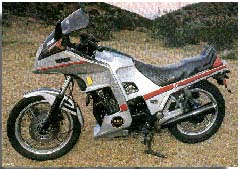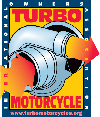|
1982/83 Yamaha XJ650LJ/LK
Seca Turbos

|
|
|
|
Suggested price in 1982/1983
|
$4,999/$3500
|
|
Suggested price for 1982/1983 in 1984
|
$2,799.00/$3099.00
|
|
ENGINE
|
|
|
Type
|
Air-cooled transverse turbocharged four-stroke in-line four
(Mitsu TCO3 39mm turbo with two-stage wastegate 7.7 psi stock/11
psi with Power-Up Kit)
70 RWHP (stock 7.7 psi)/85 RWHP (11 psi) with Power-Up Kit/90
with wastegate disconnected (15 psi). Max horsepower 95@7500 rpm
and 18 psi boost, max 70 ft/lbs. torque@ 7000 rpm.
Slightly hot-rodded (jetted, poppet valve shimmed, Dyna coils,
.020” plug gap) RWHP@psi – 65@6
-
85@10 -
90@15 -
93@16
- 94@17- 95@18
|
|
Valve arrangement
|
DOHC, 2 valves per cylinder, adjusting shims on top of buckets
|
|
Carburetion
|
Four 30mm pressurized Mikuni CVs with Yamaha Induction Control
System (YICS) cast into head
Holley 12-887 adjustable fuel pressure regulator highly
recommended.
|
|
Displacement
|
653cc
|
|
DRIVE TRAIN
|
|
|
Clutch
|
Wet, multi-plate, 5-speed
|
|
Final Drive
|
Shaft. 4.179:1
|
|
CHASSIS
|
|
|
Front suspension
|
36mm Showa ('83: 37mm), 5.5 in. travel, adjustments for air
pressure
|
|
Rear suspension
|
Dual Showa dampers, 3.1 in wheel travel, adjustments for air
pressure, rebound damping
|
|
Front tire
|
3.25 V19 Bridgestone Mag. Mopus L3030
|
|
Rear tire
|
120/90 V18, Bridgestone Mag. Mopus G508
|
|
Wet weight
|
565 lbs. (257 kg)/515 lbs. with fairing, side panels, rear
trim, and wastegate pipe removed with wg giving a stock Kaw Turbo
power/weight ratio of 5.7:1).
|
|
Fuel capacity
|
4.2 gal. (15.75 L), '83: 5.2 gal. (19.5 L)
|
|
PERFORMANCE
|
|
|
Average touring range
|
198 miles ('83: 246 miles)
|
|
Best 1/4 mile acceleration
|
12.68 sec.@106.13 mph (Cycle World , June 1982) stock
7.7 psi (without Power-Up Kit)
12.06 sec.@109.89 mph with wastegate disconnected @15 psi
(Cycle World , July 1983)
|
|
200 yd. top-gear accel. from 50 mph
|
74.5 mph terminal speed, stock (without Power-Up Kit)
|
|
Total production
|
Est. '82 - 6500/ '83 -1500/Highest recorded serial number '82 –
62xx, '83 - 957
|
|
Total imported into U.S.
|
?
|
Best
press quote:
"The Turbo Seca
transforms itself from motorcycle to superbike and back again with
ease, and the transformation is simply controlled by the right
wrist."
Cycle World, June 1981
Hot
on the heels of Honda's CX500 Turbo, the Yamaha 650 Seca Turbo,
despite its futuristic looks, was something totally different. With
air instead of water cooling, four instead of two cylinders, and,
interestingly of all, pressurized carbs in place of fuel injection,
the blown Seca took an entirely different approach to what a
turbocharged motorcycle should be.
Many
expressed doubts as to the durability of an air-cooled engine under
duress of a turbocharger; those reservations would prove unfounded
(80,000+ mile Seca Turbos that have never had major engine work or
even blown a turbocharger are quite common). The pressurized carbs
worked very well. "Best carbureted bike I've ever ridden"-
Bob Miller, President, T.M.I.O.A.).
Without
the Power-Up Kit it was the slowest of the Turbos, but with the
Power-Up Kit installed, the Yamaha Turbo could trounce the Suzuki
Turbo and be on par with a CX500TC. Disconnecting the wastegate would
make it faster than the CX500TC, but slightly slower than a CX650TD
and absolutely left in the turbocharged haze of the Kawasaki. Where
the Seca Turbo failed was in the chassis department. Unlike the other
factory Turbos Yamaha simply used a stock XJ650 frame for the LJ --
big mistake. A little more effort in this area could have made a
world of difference in handling.
'82
Seca Turbos suffered from weak performance when they were initially
introduced. Tired of being embarrassed by Honda CX500 Turbos in
head-to-head tests Yamaha rushed out a "Power-Up" kit (free
of charge!) that consisted of an inline boost pressure
sensor/restrictor that fooled the turbo into thinking boost was lower
than it was, and a washer that you stuck at the end of your
right-side turbo exhaust muffler to increase back pressure. Both
measures were designed to increase boost pressure and keep it in the
cylinders longer. Peak boost went from an anemic 7 psi to a
respectable 12 psi. The bad news for '82 Seca Turbo owners ('83
models came with the modification) is that Yamaha ran out of the kits
in 1985. The good news is that you don't need it. Simply disconnect
the vacuum hose leading to the wastegate actuator, clamp it shut,
close up the hole in the actuator and experience the thrill of 14
psi. The poppet valve in the surge tank now serves as your
"wastegate" to keep the engine from exploding. This also
solves the problem of turbocharger wastegates failing to close, a
common cause of power loss in Yamaha Turbos (blame it on the
placement of the unit under the engine where it collects all sorts of
road debris).
The
Power-Up Kit, thicker forks and a larger 5-gallon gas tank in 1983
helped sales somewhat, but a price drop to $3100 in 1984 (an '82
could be had for $2800) helped more to clear the floors of unwanted
Seca Turbos. Average Seca Turbos go for $2,500-3,500. Low mileage
bikes bring about $3,500 to $4,500 today. Showroom/museum examples
may fetch $5,000, but Seca Turbos in such a state are extremely rare.
'83 models, with their 1mm thicker forks and 1 gallon larger gas
tanks may bring a bit more.
Bikes
Home
Disclaimer
© Turbo Motorcycle International
Owners Association

